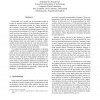Free Online Productivity Tools
i2Speak
i2Symbol
i2OCR
iTex2Img
iWeb2Print
iWeb2Shot
i2Type
iPdf2Split
iPdf2Merge
i2Bopomofo
i2Arabic
i2Style
i2Image
i2PDF
iLatex2Rtf
Sci2ools
HLK
2003
IEEE
2003
IEEE
Generic Deformable Implicit Mesh Models for Automated Reconstruction
Deformable 3–D models can be represented either as explicit or implicit surfaces. Explicit surfaces, such as triangulations or wire-frame models, are widely accepted in the Computer Vision and Computer Graphics communities. However, for automated modeling purposes, they suffer from the fact that fitting to 2–D and 3–D image-data typically involves minimization of the Euclidean distance between observations and their closest facets, which is a nondifferentiable distance function. By contrast, implicit surface representations allow fitting by minimizing an algebraic distance where one only needs to evaluate a differentiable field potential function at every data point. However, they have not gained wide acceptance because they are harder to meaningfully deform and render. To combine the strength of both approaches, we propose a method that can turn a completely arbitrary triangulated mesh, such as one taken from the web, into an implicit surface that closely approximates its sh...
Explicit Surfaces | HLK 2003 | Implicit Surface Representations | Implicit Surfaces | Information Retrieval |
| Added | 04 Jul 2010 |
| Updated | 04 Jul 2010 |
| Type | Conference |
| Year | 2003 |
| Where | HLK |
| Authors | Slobodan Ilic, Pascal Fua |
Comments (0)

